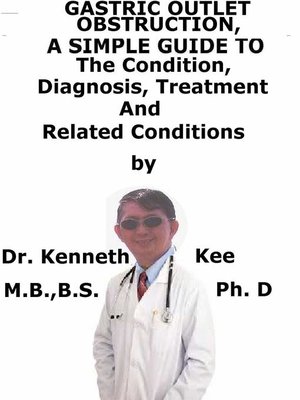Gastric Outlet Obstruction, a Simple Guide to the Condition, Diagnosis, Treatment and Related Conditions
ebook
By Kenneth Kee

Sign up to save your library
With an OverDrive account, you can save your favorite libraries for at-a-glance information about availability. Find out more about OverDrive accounts.
Find this title in Libby, the library reading app by OverDrive.



Search for a digital library with this title
Title found at these libraries:
| Loading... |
This book describes Gastric Outlet Obstruction, Diagnosis and Treatment and Related Diseases
Gastric outlet obstruction is a disorder where there is an obstruction in the outlet opening of the stomach (Pylorus), blocking the entrance of ingested food coming from the stomach to the duodenum
Causes
In children, gastric outlet obstruction can have two possible causes:
A. Mechanical obstruction happens when the exit to the stomach is narrowed but the gastric nervous and muscular systems are intact.
The causes of mechanical obstruction can be perinatal or postnatal.
The perinatal causes mainly are anatomical anomalies as:
1. Antral webs,
2. Congenital gastric atresias,
3. Pyloric stenosis,
4. Annular pancreas or
5. Gastric duplication cysts or
6. Hyper-trophic pyloric stenosis,
Most of these manifest at an older age.
The postnatal causes vary from:
1. More frequent peptic ulcer disease and healing burns from caustic ingestion
2. More uncommon causes as eosinophilic gastroenteritis or Crohn's disease, both infectious and noninfectious.
The often implicated drugs are:
1. Non-steroidal anti-inflammatory drugs
2. Macrolide
3. Fluoxetine in pregnancy
4. Opiates
5. Lipitor
The frequent causes of luminal obstruction are:
1. Gastric bezoar
2. Percutaneous endoscopic gastrostomy tube migration
3. Malrotation
4. Gastric polyps
5. Diaphragmatic hernia
6. Acute or chronic pancreatitis causing external compression,
7. Pancreatic pseudocyst,
8. Hematomas (traumatic or Henoch-Schonlein purpura),
9. Duodenal hamartoma,
10. Extrinsic band,
11. Lymphomas
B. Functional causes of gastroparesis are neurological causes that could be:
1. Acute, due to
a. Viral infections,
b. Electrolyte anomalies
c. Surrounding tissue inflammation
2. Chronic as seen in
a. Uncontrolled diabetes
b. Intrinsic muscular diseases
Symptoms
Vomiting
Epigastric pain
Constipation
Loss of weight
Hypo-kalemia and metabolic acidosis
Satiety
Abnormal enlargement of the stomach
Diagnosis:
Physical Assessment
An abdominal X-ray
Endoscopic gastrostomy
Abdominal ultrasound
CT scan abdomen
Electrolytes levels
Treatment:
Proton pump inhibitors
Nasogastric suction
Electrolytes replacement
Surgical treatment:
Antrectomy is the surgical removal of the antrum, the part of the stomach just inside the pylorus
Vagotomy involves cutting one or more branches of the Vagus nerve to reduce gastric acid
Billroth I is the removal of the Pylorus followed by the connection of the proximal stomach to the duodenum.
The operation is for the treatment of peptic ulcer and gastric cancer
Gastrojejunostomy or Billroth II is a surgical procedure that develops a connection between the jejunum (the middle part of the small intestine between the duodenum and ileum) and the stomach
Parenteral Nutrition
Supplementary nutrients through Total Parenteral Nutrition (TPN) or Distal feeding tube are helpful among patients with gastric outlet obstruction since their nutritional status normally gets worse.
Children:
In children, the doctors attempt to treat most cases conservatively.
The large percentage of these patients manifest with significant esophageal and gastric irritation due to obstruction of flow and acid reflux
They hence need adjunct medical therapy with:
1. Proton pump inhibitors,
2. Sucralfate or
3. Steroids.
With an advanced endoscopic approach the doctors can do:
1....






